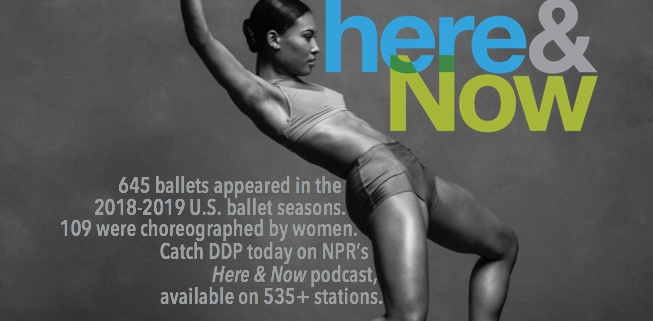December 23, 2019 Northfield, Illinois Dance Data Project® (DDP) research was discussed in a Here & Now piece on National Public Radio (NPR) on Friday, December 20. Following reporter Sharon Basco’s initial investigation of the lack of women choreographers in ballet, published in WBUR’s The ARTery and covered in a Here & Now story in 2015, the program discussed the shifting “no girls allowed” atmosphere in the artform.
The 2012-2013 ballet season
research by Amy Seiwert and Joseph Copley – in which of 290 ballets programmed
by a sample of companies that season, just 25 were choreographed by women – set
the stage for the story. “Major companies went year after year without staging
a single ballet by a woman,” narrated Basco, “People began to take notice.” Former
chief dance critic of the New York Times, Alastair Macaulay, was one of those
people, Basco shared, “[Macaulay] points to an awakening in the past few years –
and changes are underway, starting with several companies hiring female
artistic directors.”
The notion that having more women
running ballet companies may serve as a catalyst in the growing equity in
ballet, has often been discussed, and has been reflected in the seasons of
companies like the English National Ballet, Cincinnati Ballet, and more. Basco
interviewed the artistic director of the former, Tamara Rojo, who agreed, stating,
“Today it will be very, very strange for any company to announce a season where
there is no female representation.”
Basco noted, however, that female
representation in programming is just the tip of the iceberg. Citing DDP’s July
2019 report, she said, “This season, fewer than 20% of ballets are by female
choreographers.” Furthermore, she noted, “The women commissioned for major work
do so mainly as freelancers, not resident choreographers.” As the DDP team conducted
research this month on global resident choreographers, indeed, not one of the “Top
10” U.S. ballet companies (ranked by budget) had a female resident choreographer
in 2019. Women are rarely afforded the “luxury of an institutional home,” and,
beyond this, they are often paid only a fraction of the compensation offered to
male choreographers. Twenty-seven-year-old choreographer (and principal dancer
at New York City Ballet) Lauren Lovette weighed in, saying, “That is the next
step. It’s like, okay, thank you for giving an opportunity, now will you pay me
the same?”
One of the rare “exceptions” to the
glass ceiling is veteran choreographer Helen Pickett, who concluded the piece
on an optimistic note, saying, “This is the ground we walk on now – that WE
walk on now – and let’s keep on going forward with that.”
DDP will release more findings in January
following an investigation of the role of equity in major U.S. dance venue
leadership and programming, as well as the first global study of resident
choreographers.
Listen to the story on WBUR’s website or below:






Leave a Reply
Want to join the discussion?Feel free to contribute!